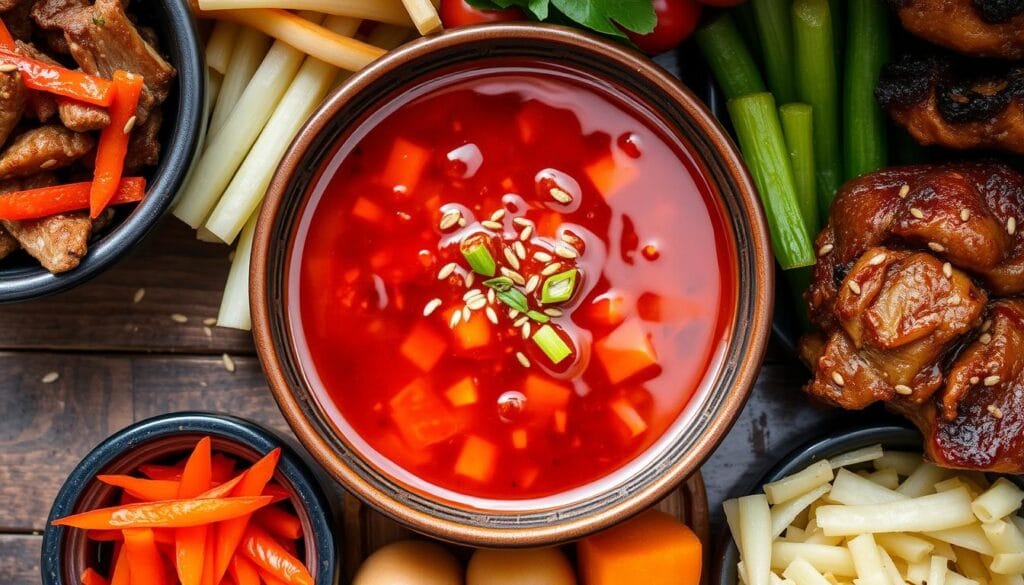Creamy Korean Ssamjang Pasta: A Fusion Delight
I love exploring international cuisine for its vibrant flavors and rich traditions. Today, I’m excited to share a dish that combines Italian pasta with Korean ssamjang. This fusion, Creamy Korean Ssamjang Pasta, is a true culinary adventure. It will take your taste buds on a delightful journey.
Table of Contents
Understanding Ssamjang: The Heart of Korean Flavors
Ssamjang is a key condiment in Korean food that has won over many fans. It’s made from Korean chili paste and soybean paste. This mix is the base of many favorite Korean dishes, linking different flavors together.
Traditional Components of Ssamjang
Ssamjang combines two main Korean ingredients: gochujang and doenjang. Gochujang is spicy and rich, while doenjang is savory. Together with garlic, onions, and sesame seeds, they make ssamjang’s bold yet balanced taste.
Cultural Significance in Korean Cuisine
Ssamjang is more than a condiment; it’s deeply rooted in Korean culture. It’s served with grilled meats, called ssam. The ssamjang adds flavor to the meat wrapped in greens. This tradition shows the balance of flavors that’s key to Korean cooking.

“Ssamjang is not just a condiment, but a reflection of the Korean people’s deep appreciation for the interplay of flavors and the art of balancing spice, umami, and sweetness.”
The Art of Making Creamy Korean Ssamjang Pasta
Making creamy Korean ssamjang pasta is a mix of Italian and Korean cooking. It’s a dish that brings together the comfort of pasta and the bold flavors of Korean ssamjang. This condiment is known for its savory, umami taste.
It starts with perfectly cooked pasta. Its firm texture is ideal for the creamy sauce. The secret is in mixing the flavors of ssamjang into a smooth sauce.
- Ssamjang, made from Korean chili paste, fermented soybean paste, and spices, gives the dish its unique taste and smell.
- Ingredients like garlic, scallions, and sesame oil add to the flavor, making the dish rich and complex.
- Adding heavy cream or crème fraîche makes the sauce creamy and indulgent.
The magic of creamy Korean ssamjang pasta is in blending these elements. Each part is crucial for a dish that looks and tastes great. It’s a mix of Italian and Korean cooking that invites you to explore new flavors with every bite.
“Pasta has always been a canvas for chefs to experiment with, and the fusion of Korean and Italian flavors is a testament to the endless possibilities in the culinary world.”
– Dan Pashman, renowned food writer and host of The Sporkful podcast.
Essential Ingredients for Perfect Ssamjang Pasta
To make a delicious Creamy Korean Ssamjang Pasta, you need some key Korean ingredients. Ssamjang, gochujang sauce, and gochugaru chili flakes are crucial. They bring out the rich and complex flavors of the dish.
Korean Pantry Staples
- Ssamjang – A savory Korean condiment made with fermented soybean paste, gochujang sauce, garlic, and more.
- Gochujang Sauce – A thick, spicy-sweet Korean chili paste that adds depth and heat.
- Gochugaru Chili Flakes – Coarse Korean chili powder with a smoky-sweet flavor and moderate spice.
Pasta and Cream Selection Tips
Choose long, thin noodles like spaghetti or linguine for the pasta. This helps the creamy ssamjang sauce stick well. For the cream, pick a rich dairy-based cream or a top-notch plant-based option. This will give the dish its velvety texture.
Fresh Components and Garnishes
To balance the bold Korean flavors, add fresh elements. Use thinly sliced green onions, toasted sesame seeds, and a bit more gochugaru chili flakes. This makes the dish look great and taste even better.
“The perfect Creamy Korean Ssamjang Pasta is all about striking a harmonious balance between the savory, spicy, and umami-rich flavors of traditional Korean ingredients and the comforting creaminess of the pasta.”
Kitchen Tools and Equipment Needed
To make a delicious creamy Korean ssamjang pasta, you need some key tools. From boiling the pasta to making the tasty sauce, the right equipment makes cooking easy and fun.
You’ll start with a big pot for cooking the pasta. This ensures you have enough room to boil the noodles without them sticking. A saucepan is vital for heating the ssamjang cream sauce. It helps mix the flavors for a smooth, creamy sauce.
A colander is a must for draining the pasta. It keeps the noodles separate from the water. This prevents the pasta from getting soggy, keeping it just right in the final dish.
- Large pot for boiling pasta
- Saucepan for simmering the ssamjang cream sauce
- Colander for draining the cooked pasta
- Whisk for blending the sauce ingredients
- Measuring spoons and cups for precise ingredient proportions
A whisk is also very helpful. It mixes the ssamjang paste, cream, and other sauce parts for a smooth texture. You’ll also need measuring spoons and cups. They help you get the right amounts of ingredients, like ssamjang paste and seasonings, for the perfect flavor.
With these tools, you’re ready to make a fantastic creamy Korean ssamjang pasta. It will surely impress your taste buds.
Step-by-Step Cooking Process
Making creamy ssamjang pasta is a fun journey. It mixes Korean tastes with pasta’s comfort. Let’s explore how to make this tasty dish.
Pasta Preparation Techniques
First, boil a big pot of salted water. Cook your pasta, like spaghetti, until it’s al dente. Save about 1 cup of the water before draining the pasta.
Sauce Building Methods
In another pan, melt butter over medium heat. Add minced garlic and cook until it smells good. Then, mix in ssamjang dressing, honey, and vinegar. Slowly add the saved water, whisking to make a smooth sauce.
Assembly and Finishing Touches
Put the cooked pasta in the sauce. Toss it well to coat each strand. Season with salt and pepper to get the right taste.
To finish, add fresh cilantro or scallions on top. This adds color and freshness. Enjoy the mix of textures and tastes in every bite.
| Ingredient | Quantity (per Serving) |
|---|---|
| Spaghetti | 4 to 5 ounces, fresh or instant ramen noodles |
| Unsalted Butter | 1½ tablespoons |
| Garlic Cloves | 3 cloves, minced |
| Gochujang (Korean Chili Paste) | 1 heaping tablespoon |
| Honey | 1 tablespoon |
| Sherry Vinegar or Rice Vinegar | 1 tablespoon |
| Cilantro or Scallions (for garnish) | As desired |
Getting the perfect balance is key. Adjust the ingredients to your taste. Enjoy this delicious mix!
Customizing Your Spice Level
One of the best things about creamy Korean ssamjang pasta is the ability to adjust the spice level to your personal preference. This versatility allows you to create a dish that perfectly suits your taste buds.
The key to controlling the heat in this fusion delight lies in the amount of gochugaru chili flakes and korean chili paste you use. For a milder version, simply reduce the quantity of these spicy components. On the other hand, if you crave an extra fiery kick, you can increase the proportions or even add fresh chili peppers to the mix.
| Spice Level | Gochugaru Chili Flakes | Korean Chili Paste |
|---|---|---|
| Mild | 1-2 tbsp | 2-3 tbsp |
| Medium | 2-3 tbsp | 3-4 tbsp |
| Spicy | 3-4 tbsp | 4-5 tbsp |
| Extra Spicy | 4-5 tbsp | 5-6 tbsp |
Remember, the balance of these two key ingredients – gochugaru chili flakes and korean chili paste – is the key to unlocking your perfect level of spiciness. Adjust the quantities according to your personal preference and enjoy the customized creamy Korean ssamjang pasta that tantalizes your taste buds.
Plant-Based Variations and Substitutions
Want to enjoy creamy Korean ssamjang pasta without dairy? Don’t worry! Vegan versions are just as tasty. The trick is to find plant-based cream alternatives and protein sources that match the traditional dish’s creaminess and heartiness.
Vegan Cream Alternatives
Cashew cream is a great substitute for dairy cream in ssamjang pasta. Just soak raw cashews in water, then blend them into a smooth, creamy mix. Coconut milk also works well, adding a rich, velvety texture to the sauce. For a nut-free option, oat milk or soy milk can be used as the base for your vegan cream.
Protein Options for Vegans
- Tofu: Firm or extra-firm tofu can be cubed and sautéed to add a delightful protein-packed component to your vegan ssamjang pasta.
- Tempeh: This fermented soy-based product offers a meatier texture and a subtle nutty flavor that pairs beautifully with the ssamjang sauce.
- Plant-based meat substitutes: From soy-based crumbles to shredded “chicken” alternatives, there are countless vegan protein options to choose from to make your ssamjang pasta even more satisfying.
Make sure the ssamjang you use is vegan-friendly. Some traditional versions may have fish sauce or other non-vegan ingredients. With a little creativity and the right plant-based substitutions, you can enjoy the bold, flavorful essence of creamy Korean ssamjang pasta in a 100% vegan-friendly way.
Pairing Suggestions and Side Dishes
The creamy and spicy Korean ssamjang pasta goes well with many side dishes. Try it with a refreshing salad or tangy kimchi to balance its bold flavors.
For drinks, a cold Korean beer or crisp white wine is great. They help tame the spice and cut through the creaminess. This dish is versatile, making it perfect for a variety of pairings for a satisfying meal.
Refreshing Salad Pairings
- A simple green salad with a light vinaigrette dressing
- A crunchy cabbage slaw with a tangy Korean-inspired dressing
- A fragrant herb salad with fresh herbs like mint, cilantro, and basil
Savory Side Dish Options
- Traditional Korean kimchi, offering a burst of fermented flavors
- Sautéed or steamed vegetables, such as spinach, bok choy, or mushrooms
- Warm, freshly baked Korean-style garlic bread
| Beverage Pairing | Description |
|---|---|
| Korean Beer | The crisp and refreshing nature of a Korean beer, such as Hite or Cass, can help balance the rich and spicy flavors of the korean-inspired pasta. |
| Dry White Wine | A dry white wine, like a Sauvignon Blanc or Pinot Grigio, can provide a refreshing contrast to the creamy and bold ssamjang pasta. |
Exploring these pairing suggestions and side dish options can enhance your korean dishes experience. It creates a well-rounded and harmonious meal that highlights the best of Korean and Italian flavors.
“The key to a perfect korean-inspired pasta dish is finding the right balance between the rich, creamy sauce and the refreshing accompaniments.”
Storage and Reheating Guidelines
Enjoying leftover creamy Korean ssamjang pasta is best when you store and reheat it right. This keeps the dish’s flavors and creamy texture just right. Follow these tips to enjoy your ssamjang pasta goodness even after the first time.
Best Practices for Leftovers
Put leftover creamy Korean ssamjang pasta in an airtight container in the fridge for up to 3 days. This keeps the flavors fresh and the pasta moist. When reheating, warm it gently on the stovetop over medium heat, stirring now and then.
Maintaining Sauce Consistency
To keep your leftover creamy Korean ssamjang pasta creamy, add a bit of milk or cream when reheating. This trick brings the sauce back to its creamy state. Don’t use the microwave, as it can make the pasta rubbery and the sauce separate.
By following these tips, you can enjoy the delicious flavors of your creamy Korean ssamjang pasta for days. Reheat with confidence, knowing you’re keeping the dish’s taste and texture perfect.
Tips for Achieving Restaurant-Quality Results
Make your homemade korean-inspired pasta dishes restaurant-quality with these tips. Use top-notch ssamjang and fresh ingredients. This will blend Korean and Italian flavors beautifully.
First, cook your pasta al dente. Save some starchy water to thicken the ssamjang dressing. This keeps your pasta tender yet firm, perfect with the creamy sauce. Balance the ssamjang’s creaminess with spice and umami for a rich flavor.
Season carefully, adjusting the ssamjang, salt, and pepper to taste. You want the sauce to enhance the pasta without dominating it. Top with toasted sesame seeds, green onions, or other garnishes for a restaurant-like finish.
Follow these tips to make a korean-inspired pasta dish at home. You’ll get a meal that’s as memorable as any restaurant’s.
“The key to exceptional korean-inspired pasta lies in the balance of flavors and the quality of the ingredients. By mastering these simple techniques, you can elevate your homemade meals to the level of a seasoned culinary professional.”
Conclusion
Creamy Korean ssamjang pasta is a mix of Italian and Korean flavors. It’s a dish that brings together the comfort of pasta with the bold tastes of Korean ssamjang. By following the steps, you can make a creamy korean ssamjang pasta dish that’s as good as in a restaurant.
Ssamjang, a key Korean condiment, adds a unique umami and spicy touch to the pasta. The creamy sauce, made with special ingredients, makes the pasta tender and enhances the dish.
If you love Korean food or want to try something new, this creamy korean ssamjang pasta recipe is perfect. It’s a fusion of cultures that will make your pasta night unforgettable.







